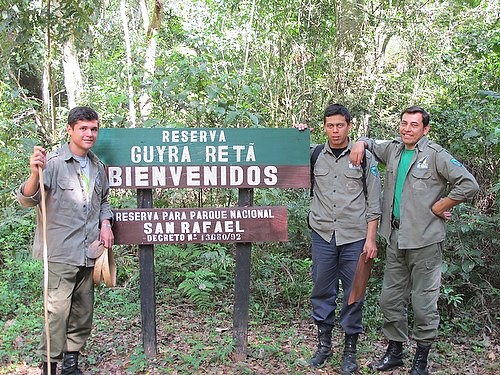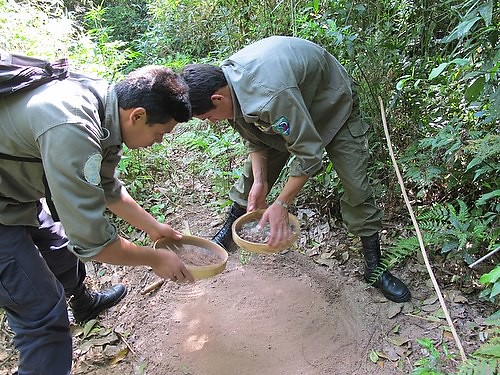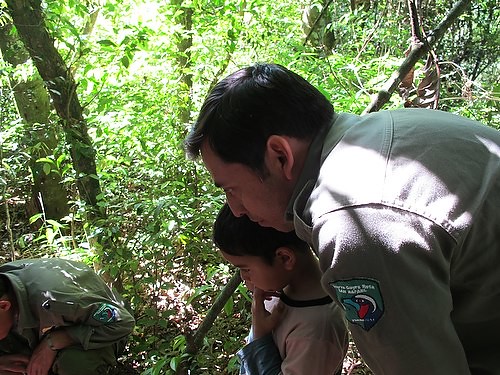SAN RAFAEL RESERVE, Alto Vera Province, Paraguay – “You are about to enter the most beautiful place in the world,” Daniel advised me as we bumped along on the rutted red road, which was growing more rutted and narrower by the minute as the dark forest closed in around us. Waist-high ferns and vine-draped trees rose in the darkness.
It had been two and a half hours since we’d left Encarnacion, Paraguay’s southern hub on the banks of the Parana, and it had been nearly an hour since we’d seen any kind of human habitation. Instead, miles and miles of wheat fields stretched to the horizon – the winter crop here, which will be harvested soon to make way for Roundup-Ready soy.
“The changes here in Alto Vera have been really dramatic in the past few years,” Daniel tells me. He’s watched as the vast Atlantic forests of his native land and the small farms that once dotted them have fallen, mile after mile, to make way for these fields.
“What’s happening is very sad,” he said. “The campesinos who have lived and farmed here all their lives are in a very precarious situation – if they have one bad season, they will be hungry all year. When a big producer comes to them and offers them money for their land, many of them can’t refuse. At $6,000 a hectare, it’s an inconceivable amount of money – they think they’ll be able to live on it for years, and they move to the city. Within a year or two, it’s all gone.”
My time in Paraguay has been colored in so many ways by the sadness of its history. I’ve come to San Rafael, however, to leave that behind for two precious days and nights in a place where a fragment of Paraguay’s former paradise remains, and a dedicated team of conservationists is working to preserve and restore it.
Among many other roles, Daniel Espinola is supervisor of operations at San Rafael and a member of the team at Guyra Paraguay, one of the country’s leading conservation groups. Its name is derived from the Guaraní word for “bird,” given that the organization’s founding mission was the preservation of bird habitat, but the group has grown far beyond its origins.
It was 10:30 by the time we arrived, and night had closed in on the forest long ago, so I would have to wait to judge the accuracy of Daniel’s description. “One always thinks their own land is the most beautiful,” he acknowledged, “so you will have to decide for yourself.”
The research station includes housing for up to 12 visitors; birdwatchers, scientists and ecotourists make their way here from all around the world to see some of the more than 400 different species of birds that make San Rafael their home.
Tomorrow, Daniel told me, I’m going to get to play forest ranger for a day. As I pulled up the comforter in the chilly night and blew out the candle, an absolute silence enveloped me and sleep descended like a warm blanket.
The light was just beginning to stream into my window when an excited commotion arose outside my cabin. It seemed that every bird in creation had gathered in our valley to put on a songbird symphony that very morning. The variety was tremendous; trills and chirps and melodious riffs interlaced in a tapestry of sound that seemed to envelop me in my half-asleep state.
I drowsed and listened for awhile, then threw open the shutters to see a gold-red peeping over the horizon. Joy was in the air; it was infectious. I understood what Daniel had meant.
Before breakfast, I saw a fork-tailed flycatcher, a southern lapwing and a – and was personally saluted by what looked like a versicolored emerald hummingbird who darted into my cabin door, hovered near me for a moment and darted back out. Afterwards I tried to settle in to do a bit of writing before our morning outing but the excitement going on outside my window was too much for me; I grabbed my binoculars and in no time had spotted a plush-crested jay and a ferruginous pygmy owl.
My day was filled with activities; I accompanied Ramon and Ariel on their rounds as they checked a series of sand “traps” set up to record the prints of the park’s feline species. I hoped to see a jaguar print and was disappointed, but we did see fox and armadillo prints. I put the binoculars Daniel loaned me to good use, In the afternoon we took a drive through the grasslands and watched as a trio of bright yellow-breasted carpintero campestres (campo flickers, a type of woodpecker) circled a giant termite hill in search of their six-legged prey and conspired to get some decent shots We spotted an amazing streamer-tailed tyrant, similar to a scissortail but with an even more dramatic double-plumed tail and beautiful cinnamon-colored face-markings, which I was also able to photograph.
Spring is bursting on the preserve, with wildflowers dotting the tallgrass prairie and the niño azote, a delicate pink mimosa-type bloom, sprinkling the forest. The male birds are wearing their most impressive plumage and singing their hearts out in hopes of attracting a mate, and migratory species linger in the vicinity, like the tyrannus savanna, the winsome black-and-white fork-tailed flycatcher I had seen in the morning.
Ariel accompanied me on a hike to the river; I watched a spectacular sunset over the mix of grasslands and forest that surround the station, and took in the riot of birdlife around its edges come back to life.
The time passed all too quickly, and soon I was on my way back to the city with Daniel, but not before visiting with a couple of the campesinos whom Guyra is working with to promote sustainable farming practices.
Stay tuned for parts 2 & 3: Daniel Espinola, from campesino to conservation leader; and visits with campesinos in the countryside.
Meanwhile, a little photo tour of San Rafael:
Created with Admarket’s flickrSLiDR.





This is really cool!! I lived in Encarnacion two years ago volunteering through the American Field Service. It was fantastic, but I wish I’d been assigned to an environmental protection/sustainability post; I didn’t get to see much of the more exotic side of the country. I’d be very interested to know more about your travels and what you’ve seen and think can be done/changed with respect to conserving and supporting their beautiful natural areas. I go back there every so often and would like to do more (and see more, if you have any particular suggestions!). I wish I were still there 😉 Happy travels!
Dear Tracy,
My name is Andrea from Guyra Paraguay, I’d organized your trip to San Rafael, I just wanted to tell you that this post its great, and I’m sharing it at the Birding Paraguay blog http://birdingparaguay.blogspot.com/2010/12/un-pedazo-de-paraiso-paraguayo-san.html
Thanks for trusting us, and visiting San Rafael!